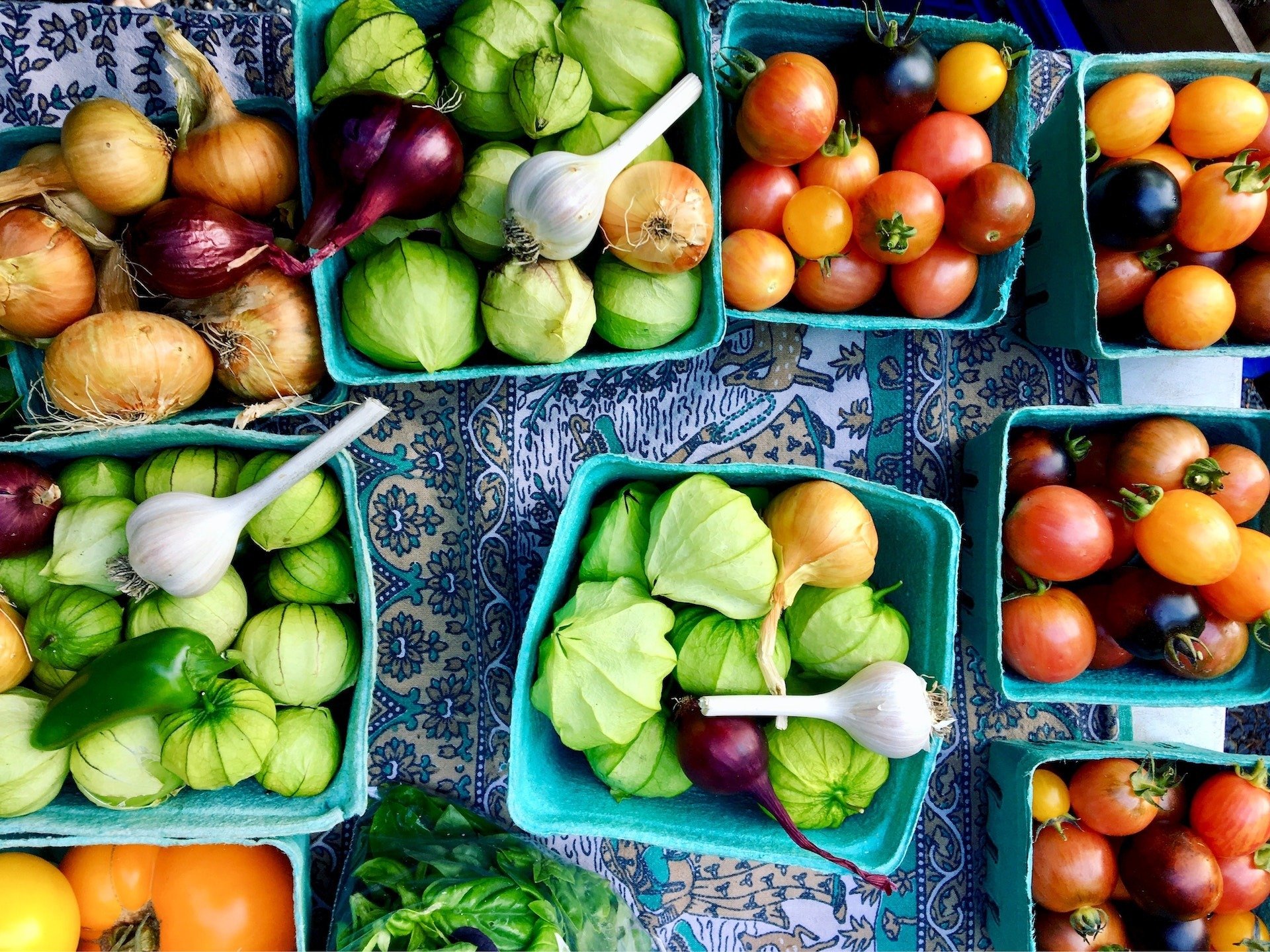Farmers’ Markets Face Year Two of the Pandemic
Before the coronavirus pandemic, farmers’ markets were more than simply a place to pick up a pint of fresh strawberries or the makings for a week full of lunch salads. They were places to gather and converse — the very heart of a community.
“It’s the must-do Saturday morning activity. It’s as much a social event as an opportunity to purchase local food,” says Tara Eaker, the event administrator for the City of Greenville, South Carolina, which operates the TD Greenville Saturday Market.
In its 19th year, the Greenville market typically attracts anywhere from 5,000 to 8,000 people to the city’s Main Street for its four hour market held every Saturday, May through October. Residents and tourists shop from more than 80 tents purchasing local food and other items, watching cooking demonstrations, listening to live music and more. When the pandemic hit, the coronavirus completely changed that experience. Gone were any nonessential parts of the market. There was no more lingering to talk; instead, organizers asked people to come with a shopping list, get their items and go home. Like the Greenville Saturday Market, markets across the country completely restructured operations during the pandemic’s height, and many questioned how to best support the community under the restricted conditions. Fast forward a year, as vaccines roll out, grocery stores feel less scary and restaurants reopen for indoor dining, and farmers’ markets are still asking themselves that question. They’re trying to figure out what they look like now and how to continue to provide fresh, local, healthy food to their communities amidst continued uncertainty.
“In Berkeley right now, people are just really, really tired,” says Carle Brinkman, food and farming program director at Ecology Center which runs farmers’ markets in Berkeley California, as well as convening the Berkeley Food Policy Council, the Berkeley Climate Action Coalition, and the California Alliance of Farmers’ Markets. “There is a real physical and emotional exhaustion that comes from operating a business and keeping people safe,” she says, sharing that they are looking at the feasibility of adding back in music, hot food, samples, and more to the city’s market. “We’re trying to figure out how do we have resilience, how do we replenish ourselves, what does [a normal] reopening look like?”
How Farmers’ Markets Serve Their Communities
In 1994, there were fewer than 2,000 farmers’ markets throughout the United States. As interest in the local food movement grew, so did markets, to more than 8,800 throughout the US, before the pandemic. However, an as of yet unknown number are expected to close permanently due to the hardships of the past year.
“Some markets closed permanently,” said Ben Feldman, executive director of the Farmers Market Coalition, a nonprofit that supports local markets across the country. “Farmers’ market operators had a very tough year, many had income decline while costs increased to continue to run the markets in a manner that is safe. It’s been a hard year.”
The impact of losing farmers’ markets would be massive. Not only are they the heart of many communities but they serve as a vital part of many farmer’s business models.
When we think of farmers’ markets, we often think of farmers and fresh local food, but it’s easy to overlook the people that make the markets happen. Just as every community is different, every farmers’ market is different and runs differently. The Greenville market, for instance, is run by the city. In contrast, the Berkeley Farmers’ Market is run as part of a nonprofit, as is the Des Moines Downtown Farmers’ Market, which is run by the nonprofit, the Greater Des Moines Partnership. Others, like the Bath Farmers Market in Maine, don’t have the backing of larger organizations.
While there was a huge level of diversity in how markets were impacted, community partnerships played a role in some markets thriving.
“One of the biggest lessons learned is that market operators that had robust community partnerships were better able to mitigate the worst impacts of COVID,” says Feldman. “For example, markets with stronger relationships with elected officials and municipal governments were more likely to be specifically identified as essential and receive guidance on how to operate safely. And that’s true across the type of partnerships.”
It’s something that Cameron Campbell, special events coordinator for the City of Greenville, South Carolina, saw firsthand. Campbell believes that the city running their market was instrumental in making the market resilient.
“Our farmers were taken care of, the consumers were taken care of and the community was taken care of and that happened because of the commitment of the city to pull it together,” Campbell says. “I really commend the city leadership for their commitment to run the market.”
In addition to community support another factor in how markets did was location.
“In general, markets that relied on commuters and tourists were hardest hit, while markets that were rural saw increases [in sales] and many markets saw fewer customers but sales were up as people stocked up for longer periods of time,” Feldman says.
How Some Markets Thrived and Survived
For many farmers whose business had previously relied on restaurants, supermarkets, and wholesale, farmers’ markets were lifelines.
“It was a vital component of our sales,” says Chris Sermons of Bio-Way Farm, who has been selling at the Greenville Saturday Market for 13 years. Sermons lost many of his restaurant sales but doubled Community Supported Agriculture shares and felt the market, while not as good as in 2019, still provided an essential source of revenue.
The coronavirus pandemic forced many markets to alter their services. Some like the Bath Farmers Market created additional ways for people to shop, such as online stores where people could preorder from multiple vendors and then pick up on the market days.
“We got new customers that we had never seen before, that really hadn’t shopped locally,” says Juliana Hoffmann, the online store coordinator of Bath Farmers Market.
Others, like the Des Moines Downtown Farmers’ Market, created programs to engage with customers, including hour-long virtual market meetups, digital vendor databases, an online vendor marketplace and a drive-through market.
“These changes were successful in helping connect customers to local vendors, but we are excited to get back to a more traditional market format in 2021 and beyond,” says Kelly Foss, director of the Des Moines Downtown Farmers’ Market.
Just what that traditional market will look like is still unknown for many of the markets. The Des Moines Downtown Farmers’ Market is moving forward with a scaled-back market, which will include as many as 115 vendors but will be spaced out more than normal. Market-goers will be required to wear masks, social distance and will be encouraged to order online in advance. All of the markets interviewed for this article are planning to take it one step at a time, continuously evaluating local, state and federal guidelines that are expected to change as COVID-19 virus infection levels and vaccination rates fluctuate in their areas.
“It’s going to be a work in progress,” Campbell says of the Greenville market. “We’ll remain conservative to maintain the health of the event staff, vendors and public but we are prepared and committed to offer a traditional experience if the opportunity arises.”
For Greenville that means the market will remain fenced in (as a crowd control measure)and they’ll continue to limit the number of vendors and visitors to make sure customers adhere to social distancing measures .
But the markets and the vendors are looking forward to the season that is just beginning and for the additional, more traditional services they might be able to offer.
“In person there’s the community aspect. I think it’s going to be busy,” says Maine’s Hoffmann.
Many are also hopeful that a silver lining of the past year will be sustained interest in cooking at home and in local food systems.
Get the latest food news, from FoodPrint.
By subscribing to communications from FoodPrint, you are agreeing to receive emails from us. We promise not to email you too often or sell your information.
Top photo by AlessandraRC/Adobe Stock.
More Reading
Can rye growers get consumers and retailers excited about rye?
May 19, 2025
How one New Jersey farm grows food year round
April 3, 2025
Returning seeds to their ancestors: Revitalizing biodiversity and foodways through plant rematriation
March 24, 2025
Fermenting and freezing are your secret weapons for preserving root vegetables
October 17, 2024
Quinces are due for a renaissance
September 16, 2024
Six unusual greens to try
September 4, 2024
These 5 new cookbooks will help you master late-summer eating
July 29, 2024
Celebrate seasonal eating with our 5-night late-summer meal plan
July 22, 2024
Some foods are styled as ‘climate saviors.’ Who are they saving?
May 21, 2024
Protecting endangered foods one bite at a time
May 6, 2024



